Having just
one 5 gallon bucket of concrete ensures fresher mud
without extra transfer work. If you have to take a phone
call, cleanup is fast. Waste is minimal. Much larger mixers make sense with
larger crews. Today's affordable and lightweight drills make hand held mixing
possible (and can even run off solar panels) . First a warning is given:
Hand held power
tools can overwhelm either a user,
the power too litself or things nearby. A beginner should approach such
work with great care and personally assume all risk.The pages of this website
are offered
only
as
a free exchange of personal experience and evolving ideas. The versitility
and portability of the electric drill has proven useful in cement mixing.
This research looks into ways of mixing with drills, inside of 5 gallon buckets. Note: These pages are placed in the The content on this website, http://harmoniouspalette.com, is placed in the public domain only as a free exchange of ideas and as a "hard studied wish to serve life". The author assumes no responsibility for the improper use of the concepts in these web pages. All relevant laws of life and local codes should be verified and observed before any building or experimentation proceeds. discussion is welcome, please write. Bo Atkinson and are furnished "as is". The author assumes no responsibility for the use or misuse of the concepts in this series.
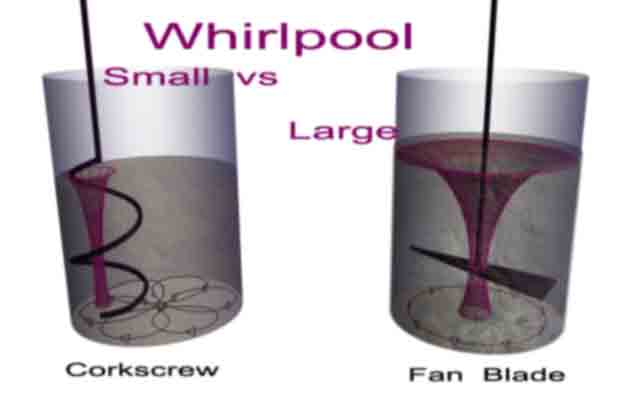
A
helix impeller which is less than half the bucket width creates a mini
whirlpool inside the helix impeller itself.
This uses less power than a full bucket
sized whirlpool. A small helix acheives layer inversion more efficiently
than a small fan like blade, as the whirlpool propels itself inside
of bucket. However a full width fan like blade can work very
smoothly
, given more power. A whirlpool is needed to invert stratified
layers within the bucket and mix them. I've
been measuring
amperage
and
a full
bucket
width
impeller can run
more than 8 amps at
300 to
500 RPM
drill
speeds. High amperage power surges apply the excess amperage
as heat within the motor. We might check this further with
precision. Does surging a 7 to 8 amp drill motor from 11 to 16 amps, on a
regular basis
hurt the motor? May we assume amperage of a drill rating is worth heeding? Very
intermittent surging and with lower surges, has, for some users, seemed
not to hurt a drill in practice. Perhaps the
heat was low enough compared to other cases of motor burnout. A Fluke
36 Clamp On Meter has been used to digitally measure actual electrical
current usage, (leading to general opinions on this page). For example,
the "S"
shaped impeller pictured below was used to whirlpool a common
5 gallon bucket of mix. A "Superhawg", 13 amp, 450 RPM angle
drill was used. Readings generally ranged just under 13 amps for a reasonably
thick mortar
consistency
of mix. Only once or twice , (within several buckets of mixes), did the
amperage exceed 13 amps, (just for an instant each time, due to stiffer
ingredients). Faster- smaller drills especially
need
reduced
loading
and a smaller helix lightens
the load
and
improves the
range
into
difficult,
sticky
or fibered mud. Bakers were perhaps the first to use slim spiral
bits
to
mix stiff
dough. Or was it some other trade? The author started experimenting
with junk auto-truck springs for concrete mixing, on a quest for small
scale, low tech automation in mixing.
That is the quest
and motivation for this prototype experimentation. More recently, ultra low
cost rebar
corkscrew mixers are also tested.

Picture Above:
A cheaply made mixer experiment using a drill with a car spring for bit/
impeller. It is resting on
a simple
hanger
which can very easily engage an electric trigger switch to allow stirring
while adding material.
See a building under construction which
used only this mixer for tons of concrete mixing. Below, same drill
mixer hangs from a welded rebar stand with slow feed hopper. Drill vibration
vibrate-feeds dry mix into bucket. Bucket is held by auto wheel with rags
tied around to softly grasp the bucket but allows bucket to turn slowly.
Some small auto wheels are nicely
sized and tapered. (Just cut out hub area). Add just enough rag to hold
pail or adjust for slow bucket rotation which wipes the full bucket-- Almost
hand free operation, while the mix is very wet, (water first). Strategy
is to add last of the dry aggregate last. Critical point here: the helix
whirl pool might haveto move around bucket or the bucket
has
to slowly
rotate to get the whirlpool to finish mixing all contents of bucket. Some
testers have not appreciated this aspect. Beware, it does take determination
to prototype tools, to balance spinning impellers and to understand contexts
of details.
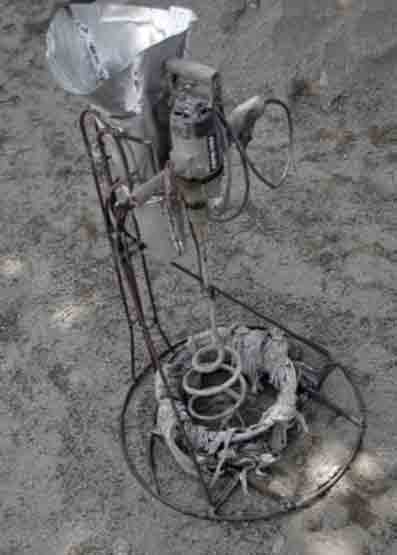
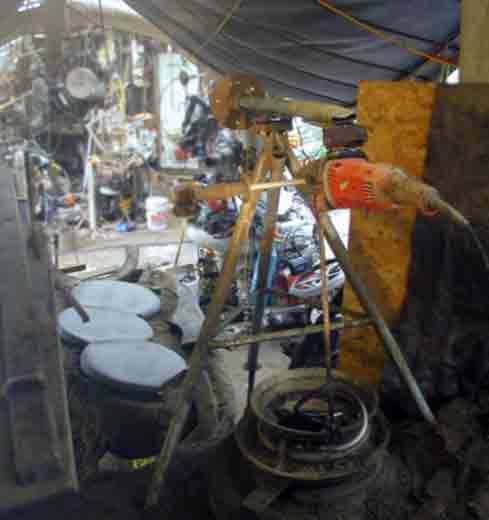
The whirlpool
of a corkscrew mixes top and bottom layers inside itself.
Additionally, it
can sweep the side, the bottom and even rotate the bucket slowly around.
The effort needed to assure this is rewarded only by cheaper toolsets.
People with better budgets or grander scales of operation will not likely
find this useful. For a corkscrew with half the bucket diameter-- The
whir pool is kept to a small fraction of the bucket volume which eases
the
load
on
the drill.
Yet the whirlpool keeps mixing the otherwise stratified layers inside
a
bucket. Layer stratification represents poor mixing. By comparison a full
bucket width impeller, can indeed whirl the entire contents of the bucket
but
does require
more power to do so. Also, full bucket whirlpools are difficult to achieve
with some particular mixes.
Extra heavy drills are available, like the "Superhawg" above
(US$340 in the 1990s). The
weight and bulk of these drills has admirably been reduced with modern
technology,
but
the
prices
can run very
high for the best drills. Slow enough speeds are not popular with most
drill uses. Slow speeds most suitable for plastic buckets are available
from gear motors but gearmotors are to heavy too hand hold. The helix impeller
research focuses on "small is beautiful", low cost small "whirlpool" mixing
and needs
only one versatile power tool: the ordinary, widely available drill along with
moderate
improvisational
skill.
(More Pictures To Come)
(More pictures
of experimental progress will be added). The "S" shape
is conveniently made from two half turns of a car-strut spring and welded
together
to form an "S". The shaft is welded to the center of the "S". This
impeller can turn smoothly and has a reversible feature when turned clockwise
vs counter clockwise. It can hook and draw ingredients away from bucket edge
or do the reverse. The reverse is a good way to expel fibers which can in higher
doses, excessively
accumulate on impellers. Modern drills like the "Superhawg" offer easy
electrical
switch for reverse rotation.
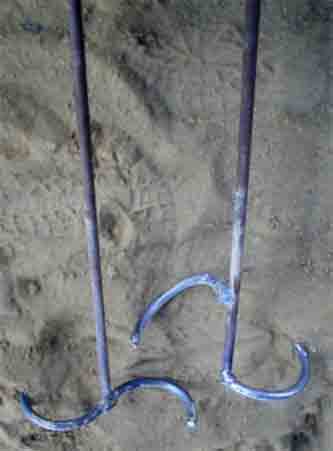
(More Pictures To Come)
Next on right side
of picture above- The "S" has
been separated into two "C" parts. One "C" part sweeps
the bucket bottom, welded to shaft end. The other "C" part is a
little higher on the shaft and angles down to gain more vertical propulsion
inside bucket. The arrangement
has seemed helpful for larger, (egg sized) aggregates. Half of a bucket diameter
happens to equal a very common spring/ strut size to be
found
in
older automotive
junk.
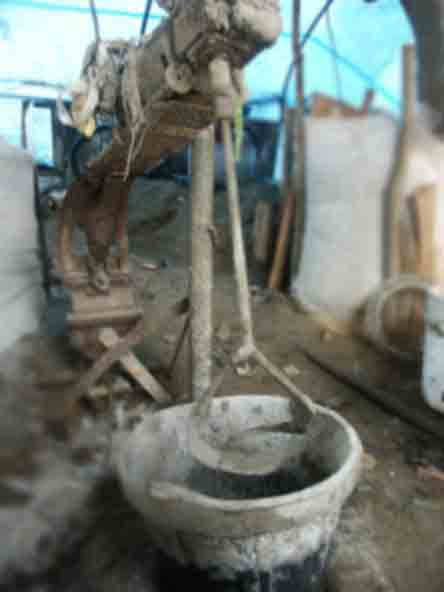 (
(
Still
needing improvement(above) is a dual "C" section
mixer more like a sculpted boat propeller shape. For a ferrocement mixer
bit, cement could fill the space between two curve shaped rods.
Next is photo of crude
version mounted on gear motor, (mixer is hinged with counter weight). Here,
a conic section) agricultural bucket is used
instead
of plastic.

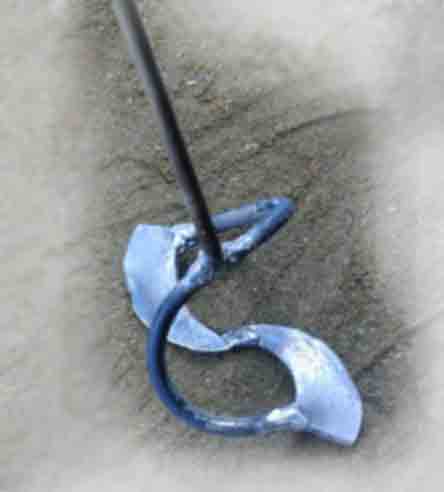
Next above is latest
prototype with two spring sizes welded into progressive double helix. Above
to right is spring section welded to flight section. More reports will follow
eventually.

Next- Above is two
flight sections for study with fiber mixing. (However a slower gear motor
needs to be fitted, without time available here at enerseasrch). Below on
left is my first full- sweep- bucket- mixer which was mounted on a 14
amp
gear
motor.
It was made of random ring parts of alloyed industrial scrap. In it's
last uses from many years ago, I was too preoccupied to wash this impeller
between batches.
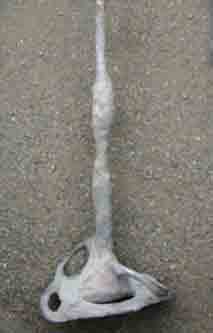
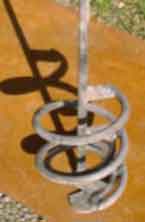
Above Right-
A cheap effort to mimic the flat ribbon impeller similar to a "flight",
see below. (A parallel bar was welded to a larger spring for
a
gear motor
to impart
greater
loft for finer mixes but more loft demands more power. Sleeker bits are better.
Below a short piece of spiral "flight" was used, (a little
wider than half the pail diameter). Flights are used for particle
conveyors and much more expensive than bending a helix. For dedicated
fine grit cement mixing, it is far cheaper to put 2 helixes together
or add a little curved plate at bottom. (See methods to bend corkscrews
or to weld car springs below). The flight was tested for mixing fine
cement, nearly instant mixing with
well timed
feeding
of
ingredients. The flight "pushes" enough
to feed a radial
peristaltic pump, (recycled radials). Metered feeding of ingredients
for batch mixing is a reasonable
possibility. A
stack of old pulleys
(found as junk), were welded together to adapt gear shaft to mixer
shaft, (different sizes). (These are tin metal and require careful use
of mixer, to avoid breaking). A counter weight (an old farming plow),
is used to ease lifting of gear motor. (Odd framework is
simply
recycled
bits
and
pieces
had on
hand).
Reversible motor is a plus. One can reverse direction to push last minute
additions to bottom. The pail/ bucket can rotate slightly as the impeller
mixes. This evenly wipes
all of
the
sides.
The height
of
pail is controlled with just enough sand in base so that pail bottom
is also wiped/ scraped.
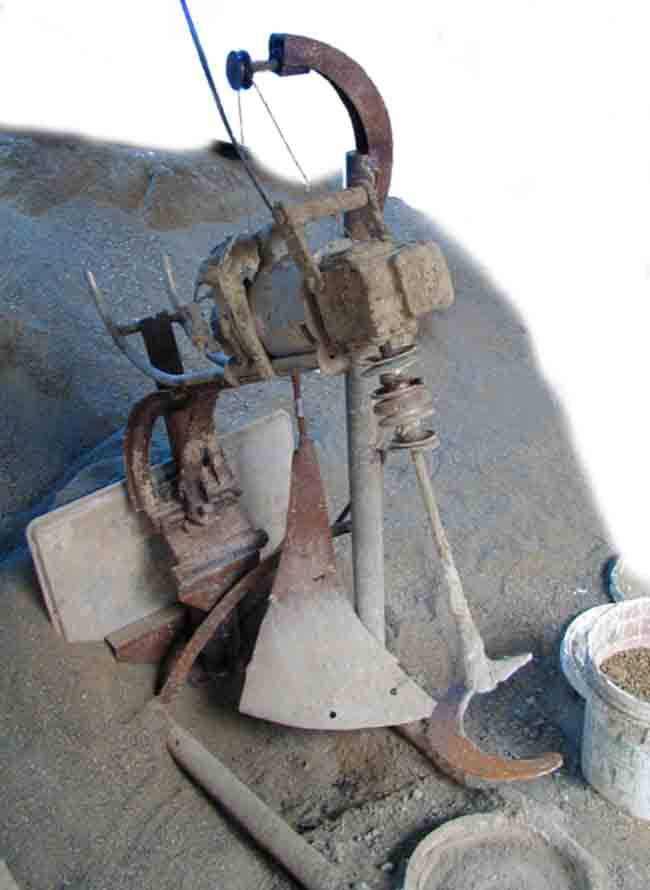
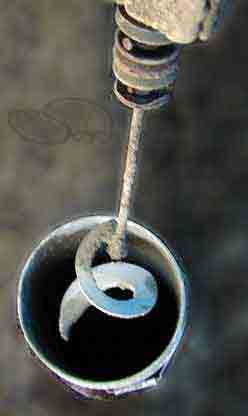
The helix mixer
above was cut from a "flight" which is a flat ribbon like helix.
It was cut and sculpted at the bottom tip with alloy welding rod. The bottom
tip has a slight fin like shape to it which helps veer the tip closer to
bucket corner. This mixer is mounted on a 14 amp gear head motor, which
in turn is mounted on a hinging stand.
Next, below is
a foot pedal bucket grabber for plastic buckets. It was improvised from
auto wheels.
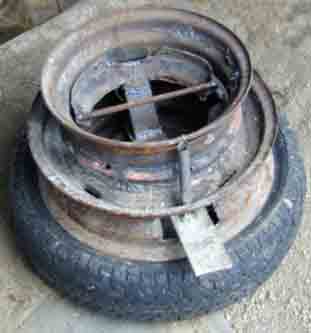
How did I build
prototype mixers from scraps?
It's easy for a serious
prototyper but maybe not for a other persons. Creative cementitious work
generally requires sufficient inspirational
motivation to push through the difficulties. This page and other linked pages
generally reflect the agony and ecstasy of creative prototypes and thinking
outside the box!
I don't have a
machine shop. Left over materials and odd scraps provide ample shims and
braces. Coffee cans or tins may fit inside of a car spring. Wrap the cans/
tins with scraps of sheet metal or mesh for a snug and more accurate
fit. Face the solid end of tin/ cans at corkscrew ends. Push a straight
rod
through center (pre-punched-drilled can/ tin ends). The rod should protrude
far enough from one end to become the drive shaft. Loosely lay a bar scrap
across shaft and corkscrew at same protruding end and weld. Then, cut away
alignment end of shaft just below weld. Weld three "bumps at
shaft end so that drill chuck can grab tighter. If you don't have a lathe
for precision grinding, this
can
give
good
slip proof centering in drill chuck. A broken SD bit also avoids the
hassle of tightening chuck in the middle of cement work. Or if you can
stand the
delays, weld the chuck to the shaft, preferably an old worn out chuck,
(cringing while welding a chuck forever closed ;) Oh well,
that solves
major frustration
when
tired of tightening chuck every ten minutes. This makes a slightly wobbly
mixer
that works acceptably, proves the theory,
but wears
down unevenly.
So when you see that, bend shaft to compensate, and re-weld to wear out
other side ;) Below are my only photos on hand which show a "do it
your self" alignment and welding. A stock coupler was selected to
match a gear motor shaft. It was temporarily held with a snug fitting socket
wrench and
rod to allow alignment with spring. This spring is a small one intended
to absorb shock. At other end a double helix impeller was welded, (see
below).
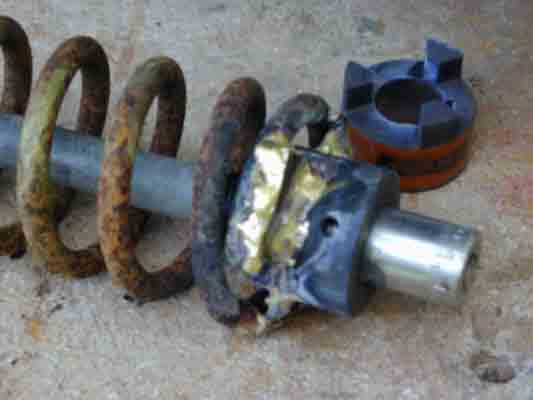
A side note is
don't fear using rusty junk. Our disposable society needs to reuse more
junk, (hereby becoming a sustainable society).
Bigger and
bigger bits will tempt the experimenter. Below is
a bucket wide, double
helix
impeller
with
steeper
pitch
than
car springs. Powerful gear motor is much heavier than a full pail of
cement. Hinging the bottom base drops pail for loading and unloading. Crank
is
seen to
left in picture, for fast hinging up and down of bucket. A lever (seen
on ground) with steel band grabs the bucket tightly. Here the problem
was that the entire load of mud was too often mobilized and turned with
double
helix impeller, (instead of mixing). I meant to remove or reduce the
bottom bucket scraper, (not easily seen). For vertical impellers which
are close to pail diameter, a counter acting but at the same time stationary
impeller would seem critical. A stationary helix would simplify design
requirements. The idea here is to explore controlled reflexive flows of
mix material for continuous mixing. This might prove useful
for automatic batching and feeding to cement pump.
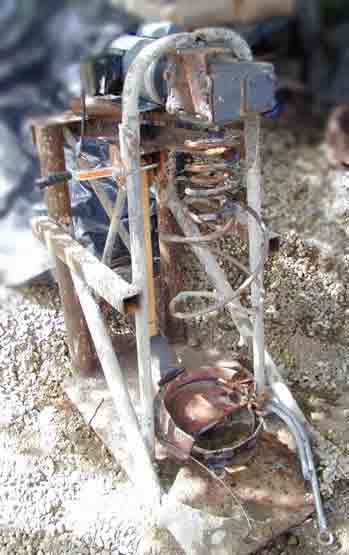
An abrasion resistant
alloy is preferable. One problem with ordinary plastic
pails is the tendency for the pails to warp into an oval shape, (due to heavy
cement lifting). If mixer users could collectively demand wear resistant
alloys, there are small alloy part producers who will customize ideal
parts. A light weight alloy pail and machine balanced impeller are reasonable
to ask for. Let me add
your name to start a list of interested users. One person's small market
impact alone is not enough. I'm willing to help promote better mixers on
a non-profit basis. I'm looking for would be developers, entrepreneurs and
vendors to work with. I prefer to remain a prototyper and artist.
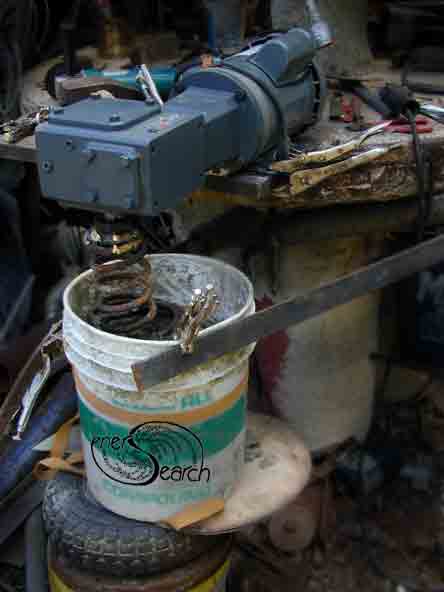
Below: For cement
preservation as well as faster production, a plastic bin is used to hold
cement. Bags are designed in such a way as to absorb atmospheric moisture
and unfortunately are harmful to cement in a humid climate. Measured amounts
of cement are scooped and added to mixing pail seen in pictures. A simple,
movable metal frame above bin with a knife like projection pierces bag. Once
pierced the bag may be opened by pulling opposite ends up and shaking. The
bin is easily open and shut in case of rain. This bin size holds 3 bags which
allows uninterrupted mixing of considerable "mud". (One should
avoid plastic bins which are or become brittle and break. Look for
guarantees in product data).
.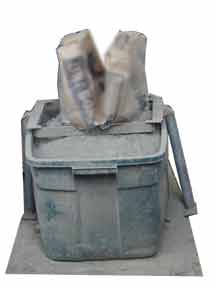
Here is my testimonial
on why i prefer bucket mixing.
I started one-man
contractor work with a rubber paddle mixer but eventually got rid of it.
(Wheel barrow load size). Usually i've worked solo, so keeping cement shaded,
(cool),
washed,
covered from rain,
in addition to the wheel barrow... plus keeping the batch tempered, the work
in stride and smoothed as well.... Failing to keep materials cool
or a bulky batch from over heating. Plus maintaining every other mechanical
thing. Minimizing tool surface
contact with cement saves time. The less contact the better. It doesn't need
much cleaning
or sun shading.
You might not fit
that spray shovel into a bucket, but i see using a simpler
spray lid adapter which could work more simply still. Just remove
mixer and put on this spray lid. Heft it to shoulder and shoot like
bazooka, (swords to plow shears).
I would love an
automatic bin fed batcher that could fill my pail like a soda machine.
I have been building toward this
for years but pulled through. Last but not least
is the physical space consumption of a project. Big equipment can get
in
the
way,
tear up
a yard, loose material, crush the wife's flowers and always costs 10 times
more than auto repair for equivalent parts. Blessed are the poor... At least
they have fewer equipment problems ;)
A page describing sand
molded concrete and ferrocement sculpture. "Earth Molded Concrete:
Artisan Secrets"
Comments
are invited. Consultancy or constructive cooperation is offered.
The content on this website, http://harmoniouspalette.com, is placed in the public domain only as a free exchange of ideas
and as a "hard studied wish to serve life". The author assumes no responsibility for the improper
use of the concepts in these web pages, as all relevant laws of life and local codes
should be verified and observed before any building or experimentation proceeds.
discussion is welcome, please write. Bo Atkinson
To
send your email comments, click here
Bo's
For Profit Menu Page,





 (
(










